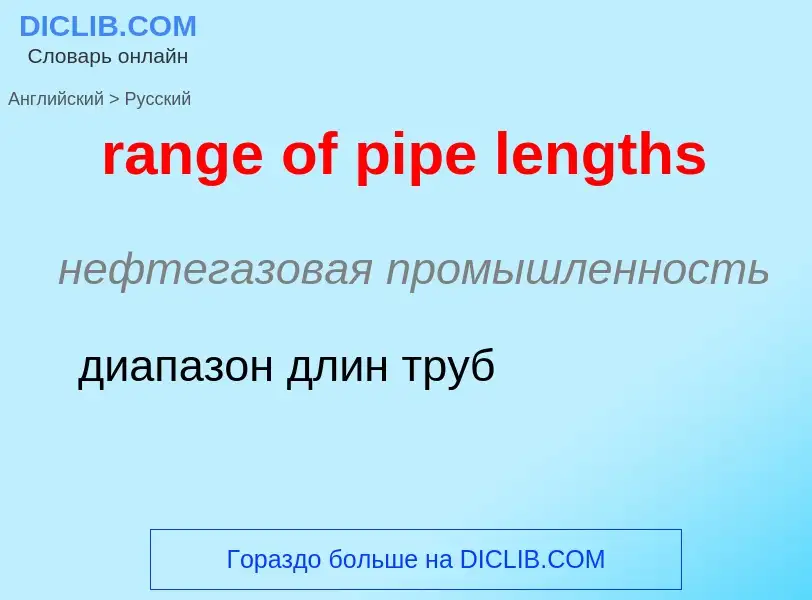Tradução e análise de palavras por inteligência artificial ChatGPT
Nesta página você pode obter uma análise detalhada de uma palavra ou frase, produzida usando a melhor tecnologia de inteligência artificial até o momento:
- como a palavra é usada
- frequência de uso
- é usado com mais frequência na fala oral ou escrita
- opções de tradução de palavras
- exemplos de uso (várias frases com tradução)
- etimologia
range of pipe lengths - tradução para russo
нефтегазовая промышленность
диапазон длин труб
[tə'bækəupaip]
общая лексика
(курительная) трубка
общая лексика
трубочный табак
Definição
Wikipédia
The persistence length is a basic mechanical property quantifying the bending stiffness of a polymer. The molecule behaves like a flexible elastic rod/beam (beam theory). Informally, for pieces of the polymer that are shorter than the persistence length, the molecule behaves like a rigid rod, while for pieces of the polymer that are much longer than the persistence length, the properties can only be described statistically, like a three-dimensional random walk.
Formally, the persistence length, P, is defined as the length over which correlations in the direction of the tangent are lost. In a more chemical based manner it can also be defined as the average sum of the projections of all bonds j ≥ i on bond i in an infinitely long chain.
Let us define the angle θ between a vector that is tangent to the polymer at position 0 (zero) and a tangent vector at a distance L away from position 0, along the contour of the chain. It can be shown that the expectation value of the cosine of the angle falls off exponentially with distance,
where P is the persistence length and the angled brackets denote the average over all starting positions.
The persistence length is considered to be one half of the Kuhn length, the length of hypothetical segments that the chain can be considered as freely joined. The persistence length equals the average projection of the end-to-end vector on the tangent to the chain contour at a chain end in the limit of infinite chain length.
The persistence length can be also expressed using the bending stiffness , the Young's modulus E and knowing the section of the polymer chain.
where is the Boltzmann constant and T is the temperature.
In the case of a rigid and uniform rod, I can be expressed as:
where a is the radius.
For charged polymers the persistence length depends on the surrounding salt concentration due to electrostatic screening. The persistence length of a charged polymer is described by the OSF (Odijk, Skolnick and Fixman) model.


![Peterson]] briar pipe Peterson]] briar pipe](https://commons.wikimedia.org/wiki/Special:FilePath/A-Peterson-pipe.jpg?width=200)
![[[Sherlock Holmes]] smoking a pipe. This color painting by Frank Wiles first appeared in the September, 1914 number of ''[[Strand Magazine]]'' to illustrate the first installment of "[[The Valley of Fear]]". [[Sherlock Holmes]] smoking a pipe. This color painting by Frank Wiles first appeared in the September, 1914 number of ''[[Strand Magazine]]'' to illustrate the first installment of "[[The Valley of Fear]]".](https://commons.wikimedia.org/wiki/Special:FilePath/Adventures with Sherlock Holmes TD Gallery Jan 5-Mar 10, 2012.jpg?width=200)
![Pipes made of [[bamboo]] buds (handmade) Pipes made of [[bamboo]] buds (handmade)](https://commons.wikimedia.org/wiki/Special:FilePath/Bamboo-buds pipes made by CuongD.jpg?width=200)
![[[Corncob]] pipe [[Corncob]] pipe](https://commons.wikimedia.org/wiki/Special:FilePath/Corncob-pipe.jpg?width=200)

![An [[Egypt]]ian hookah (shisha) An [[Egypt]]ian hookah (shisha)](https://commons.wikimedia.org/wiki/Special:FilePath/Hookah 2.jpg?width=200)
![''Inlayed Pipe Bowl with Two Faces'', early 19th century, [[Brooklyn Museum]] ''Inlayed Pipe Bowl with Two Faces'', early 19th century, [[Brooklyn Museum]]](https://commons.wikimedia.org/wiki/Special:FilePath/Inlayed Pipe Bowl with Two Faces, early 19th century,50.67.104.jpg?width=200)
![A [[meerschaum pipe]] A [[meerschaum pipe]]](https://commons.wikimedia.org/wiki/Special:FilePath/Meerschaumpfeife.jpg?width=200)
![Detail of "Old Peasant Lighting a Pipe" by [[Johann Carl Loth]] (1655/1660) Detail of "Old Peasant Lighting a Pipe" by [[Johann Carl Loth]] (1655/1660)](https://commons.wikimedia.org/wiki/Special:FilePath/Smoking Pipe.jpg?width=200)




























